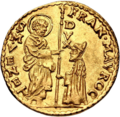Genoese lira

TheGenoese lira(Italian:Lira genovese) was the currency of theRepublic of Genoauntil 1797.
History
[edit]The mint in the Republic of Genoa began its production around 1138,[1]with coins introduced in line with similar versions issued in the rest of Europe, as follows:[2]
- The silverdenaroin 1138, containing 1.06 grams of1⁄3fine silver (or 84.8 g fine silver in a lira);
- The silvergrossoin 1172 worth 4denari,of 1.4 g of23⁄24fine silver (or 80.5 g fine silver in a lira);
- The goldGenovino d'oroin 1252, at about the same time as the Florentineflorin;of 3.5 g fine gold, and worth1⁄2lira (each lira worth either 7 g fine gold or 70 g fine silver);
- Thetestoneor 1-lira coin before 1500, containing about 13 g of23⁄24fine silver (or 12.5g fine). It was the highest-valuedItalian coinunit in the end of the 15th century.[3]
Genoese currency became important in the 16th century during theGolden age of Genoese banking,with theSpanish Empirefunnelling its massive wealth fromSpanish Americathrough theBank of Saint George.Genoathen introduced new coins, namely:[4]
- The largescudo d'argento,copying the Milaneseducaton,with 36.64 g fine silver, and worth 41⁄2lireas of 1602;
- The goldscudo d'oro,copying theSpanish escudo,with 3.026 g fine gold, and also worth 41⁄2lireas of 1602;
- The golddoppioor 2-scudo coin, also known as thedoubloonorpistole.
With the decline in the fortunes of the Genoese banks and theSpanish Empirein the 17th century, however, the Genoese lira also depreciated substantially. The silver scudo's value increased to 6.5 lire in 1646, 7.4 lire in 1671, and 8.74 lire just before theAustrian occupation of Genoain 1746.[5]
The lira in existence from the 12th century was later called the liramoneta buona(good money) or lirafuori banco(outside the bank) to disambiguate from the huge array of auxiliary units used by Genoa's banking industry to account for various currencies brought there over the centuries.[6]Each lira or unit below also divided into 20 soldi or 240 denari; the various units are as follows:[7]
- The liramoneta buonaor lirafuori banco,with 4.19 g fine silver in 1746;
- Thelira bancoworth 1.15 lire, the accounting unit of deposits in theBank of Saint George,and also dividing intosoldi bancoanddenari banco;
- Thelira moneta di paghiworth 1.214 lire for countingSpanish dollars,and thelira di cartularioworth 1.942 lire for accounting bullion sales (the various units tied up as follows: Scudo d'Argento = 8.74 lire = 7.6 lire banco = 7.2 liremoneta di paghi= 4.5 liredi cartulario);
- Other units used for exchange quotations: thepezzaworth 5.75 lire, theScudo d'Argentoworth 8.74 lire, theScudo d'Oroworth 10.81 lire, and theScudo di Cambioworth 4.6 lire; each of these units also divide intosoldianddenari.
After the 1746 siege the Genoese lira was devalued with thescudo d'argentorising from 8.74 to 9.5 lire (or 3.86 g fine silver in a lira). When the period of the Republic ended in 1797, the one lira coin weighed 4.16 g at 8/9 fine, equal to 3.70 g fine silver or 0.239 g fine gold.[8]
From 1797 the Genoese lira and all its auxiliary units were replaced by theFrench franc,and afterwards theItalian lira.However, theMintofGenoaremained in operation by issuing coins until 1860.[8]
See also
[edit]References
[edit]- ^Desimoni, Cornelio.Tavole Descrittive Delle Monete Della Zecca Di Genova Dal 1139-1814(in Italian). Nabu Press.
- ^it:Monetazione genovese
- ^M. Cipolla, Carlo.Economic History of World Population.Trophy Pr; 7 edition.
- ^Kelly, Patrick (1835).The Universal Cambist and Commercial Instructor.
- ^Serra, Girolamo.Discorso sulle monete di Genova recitato dal Signor Girolamo Serra rettore dell'Università all'Accademia delle scienze, lettere ed arti, nell'adunanza del dì 15 luglio 1810(in Italian).
- ^"Banco di San Giorgio",Wikipedia(in Italian), 2023-06-13,retrieved2023-08-29
- ^Kelly, Patrick (1821).The Universal Cambist, and Commercial Instructor: Being a Full and Accurate Treatise on the Exchanges, Monies, Weights and Measures of All Trading Nations and Their Colonies; with an Account of Their Banks, Public Funds, and Paper Currencies.
- ^abM. Cipolla, Carlo.Le avventure della lira(in Italian). Il Mulino.


